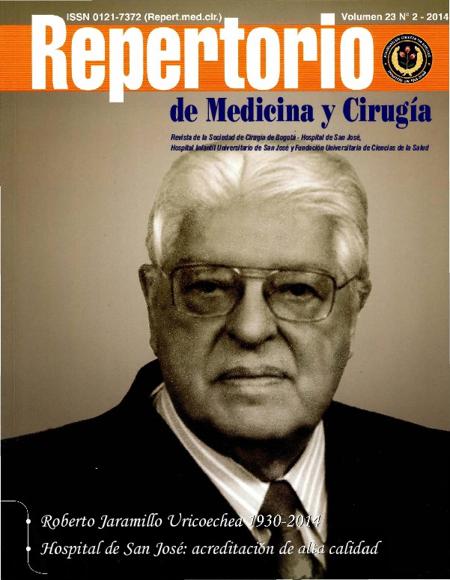Ataque cerebrovascular isquémico: Caracterización demográfica y clínica. Hospital de San José de Bogotá DC, 2012-2013
Ischemic cerebrovascular attack: Demographic and clinical characterization. Hospital of San José de Bogotá DC, 2012-2013
Esta obra está bajo una licencia internacional Creative Commons Atribución-NoComercial-CompartirIgual 4.0.
Mostrar biografía de los autores
La enfermedad cerebrovascular es de alta prevalencia mundial, siendo objeto de estudios los factores de riesgo, los desencadenantes y los programas de prevención. Objetivo: describir las características demográficas y clínicas del ACV isquémico en urgencias de los Hospitales de San José e Infantil Universitario de San José de Bogotá DC, de abril 2012 a marzo 2013. Materiales y métodos: serie de casos valorando la severidad al ingreso y egreso con la escala NIHSS y el seguimiento intrahospitalario para reportar funcionalidad, discapacidad y mortalidad. Resultados: 157 pacientes con edad media de 67 años (DE: 17.5), 58% mujeres, 110 (70,1%) con hipertensión arterial como factor de riesgo conocido. En 72 (45,9%) se evaluó la funcionalidad al ingreso, 55 eran independientes (76.3%); al egreso se aplicó a 60, encontrando dependencia moderada en 16 (26.7%) e independencia 19 (31.7%). La severidad al ingreso se valoró en 142 pacientes (NIHSS), siendo leve en 100 (63.7%). Se registró mortalidad de diez por la enfermedad cerebrovascular (6.3%). Conclusión: el instrumento diseñado permitió reconocer los factores de riesgo modificables o no, en nuestra población, las terapias de prevención secundaria e identificar fallas en abordaje y tratamiento. Abreviaturas: ACV, ataque cerebrovascular; HTA, hipertensión arterial.
Visitas del artículo 532 | Visitas PDF 928
Descargas
1. Kleindorfer DO, Khoury J, Moomaw CJ, Alwell K, Woo D, Flaherty ML, et al. Stroke Incidence is decreasing in whites, but Not in Blacks: A Population-Based Estimate of Temporal Trends in Stroke Incidence from the Greater Cincinnati/ Northern Kentucky Stroke Study. Stroke. 2010 Jul;41(7):1326-31.
2. Luis GC. Guía 8: ECV, guía neurológica [monografía en Internet]. ]. Bogotá: Asociación Colombiana de Neurología; 2013 [citado 29 abr 2014]. Disponible en: http://www.acnweb.org/es/guia-neurologica/guia-8-ecv.html
3. O’Donnell MJ, Xavier D, Liu L, Zhang H, Chin SL, Rao-Melacini P, et al. Risk factors for ischaemic and intracerebral haemorrhagic stroke in 22 countries (the INTERSTROKE study): a case-control study. Lancet. 2010;376(9735):112-23.
4. Madden KP, Karanjia PN, Adams HP Jr, Clarke WR. Accuracy of initial stroke subtype diagnosis in the TOAST study. Trial of ORG 10172 in Acute Stroke Treatment. Neurology. 1995;45(11):1975-9.
5. Kolominsky-Rabas PL, Weber M, Gefeller O, Neundoerfer B, Heuschmann PU. Epidemiology of ischemic stroke subtypes according to TOAST criteria: incidence, recurrence, and long-term survival in ischemic stroke subtypes: a populationbased study. Stroke. 2001;32(12):2735-40.
6. Bonita R, Beaglehole R. Modification of Rankin Scale: Recovery of motor function after stroke. Stroke 1988 Dec;19(12):1497-1500.
7. Rankin J. Cerebral vascular accidents in patients over the age of 60. II. Prognosis. Scott Med J. 1957;2(5):200-15.
8. Cid Ruzafa J, Damián Moreno J. Valoración de la discapacidad física: el indice de Barthel. Rev. Esp. Salud Publica. 1997;71(2):127-37.
9. Aszalos Z, Barsi P, Vitrai J, Nagy Z. Hypertension and clusters of risk factors in different stroke subtypes (an analysis of Hungarian patients via Budapest Stroke Data Bank). J Hum Hypertens. 2002;16(7):495-500.
10. Furie KL, Kasner SE, Adams RJ, Albers GW, Bush RL, Fagan SC, et al. Guidelines for the prevention of stroke in patients with stroke or transient ischemic attack: a guideline for healthcare professionals from the American Heart Association/American Stroke Association. Stroke. 2011;42(1):227-76.
11. Goldstein LB, Bushnell CD, Adams RJ, Appel LJ, Braun LT, Chaturvedi S, et al. Guidelines for the primary prevention of stroke: a guideline for healthcare professionals from the American Heart Association/American Stroke Association. Stroke. 2011;42(2):517-84.
12. Grundy SM, Becker D, Clarck LT, Cooper RS, Denke MA, Howard J, et al. ATP III Report on High Blood Cholesterol [monografía en Internet]. ]. Bethesda, Maryland: National Institutes of Health; 2002 [citado 29 abr 2014]. Disponible en: http://www.nhlbi.nih.gov/guidelines/cholesterol/atp3full.pdf
13. American Diabetes Asociation. Standards of Medical Care in Diabetes 2008. Diabetes Care. 2008 Jan;31 Suppl 1:S12-54.
14. Rahme R, Abruzzo TA, Ringer AJ. Acute ischemic stroke in the setting of cervical carotid occlusion: a proposed management strategy. World Neurosurg. 2011;76(6 Suppl):S60-5.













